Analysis of Transcultural Communication in Healthcare: A Report
VerifiedAdded on 2023/06/04
|7
|1593
|56
Report
AI Summary
This report examines transcultural communication within healthcare settings, emphasizing the importance of cultural competence and understanding diverse cultural practices. It explores how culture influences communication, including verbal and non-verbal cues, and highlights potential barriers such as lack of active listening, preconceptions, and emotional barriers. The report analyzes the legal and ethical consequences of ineffective communication, including medical malpractice and breaches of patient rights and confidentiality. It provides recommendations for improving communication, such as attentive listening and avoiding judgment, and suggests strategies for preventing communication breakdowns through staff training and policy implementation. The report underscores the critical role of effective communication in ensuring quality patient care and satisfaction.
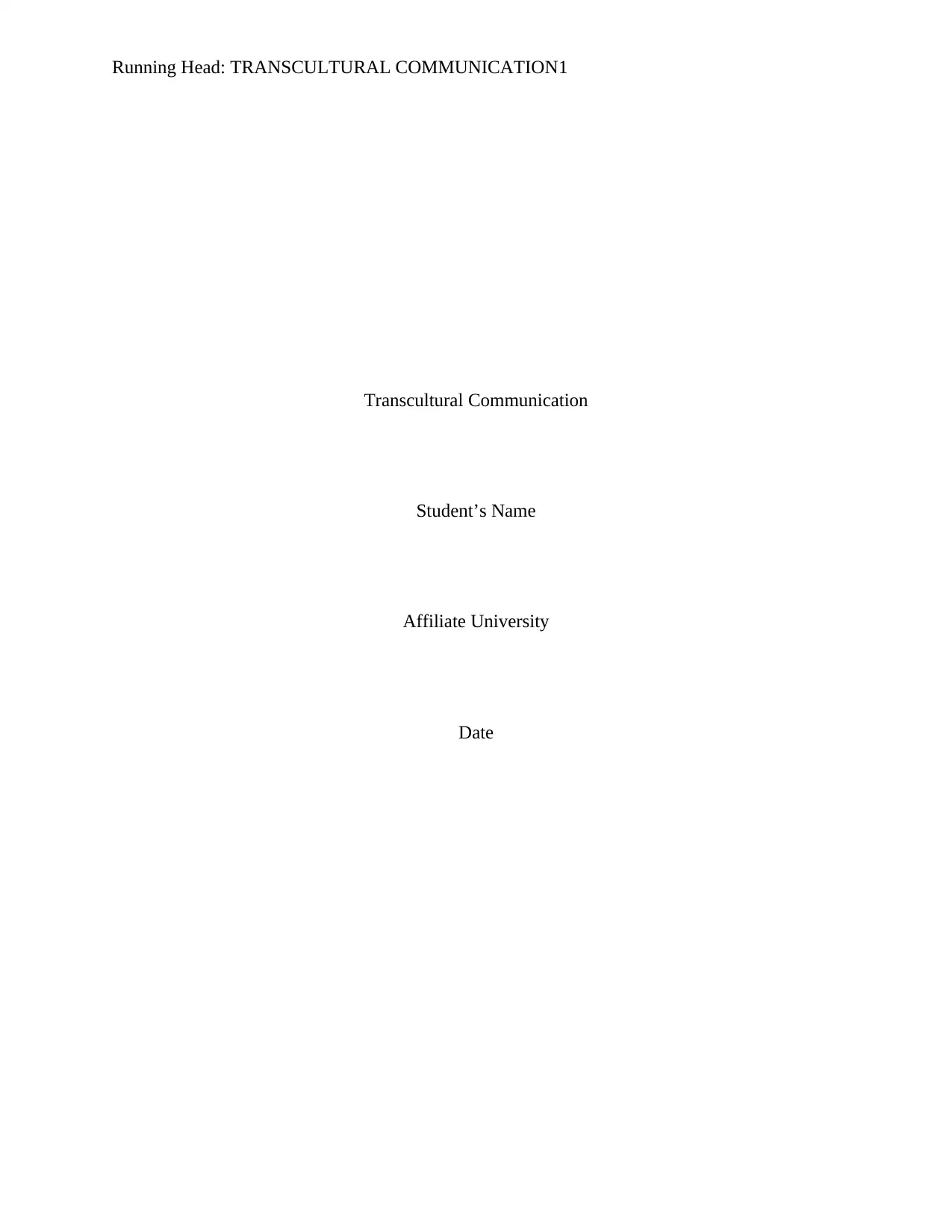
Running Head: TRANSCULTURAL COMMUNICATION1
Transcultural Communication
Student’s Name
Affiliate University
Date
Transcultural Communication
Student’s Name
Affiliate University
Date
Paraphrase This Document
Need a fresh take? Get an instant paraphrase of this document with our AI Paraphraser
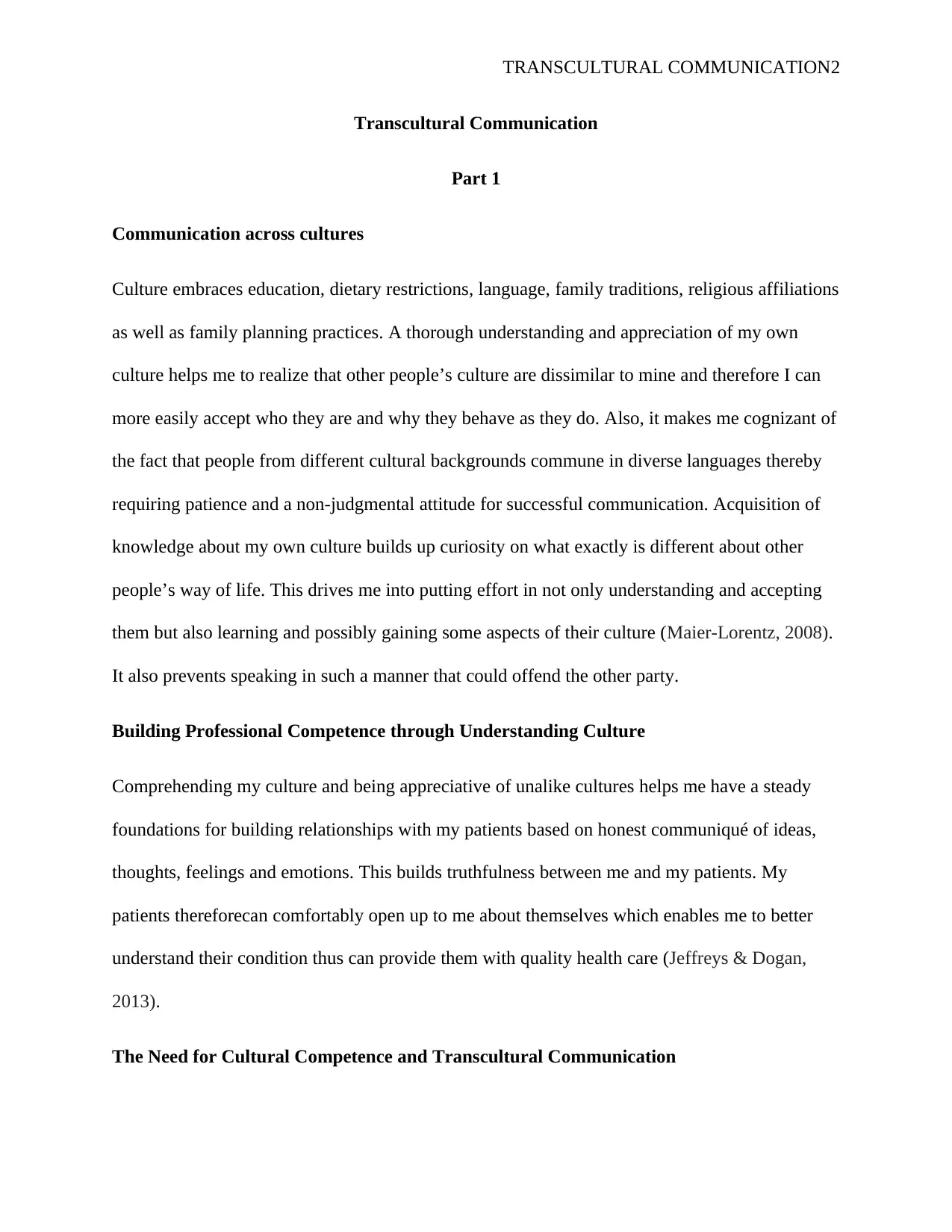
TRANSCULTURAL COMMUNICATION2
Transcultural Communication
Part 1
Communication across cultures
Culture embraces education, dietary restrictions, language, family traditions, religious affiliations
as well as family planning practices. A thorough understanding and appreciation of my own
culture helps me to realize that other people’s culture are dissimilar to mine and therefore I can
more easily accept who they are and why they behave as they do. Also, it makes me cognizant of
the fact that people from different cultural backgrounds commune in diverse languages thereby
requiring patience and a non-judgmental attitude for successful communication. Acquisition of
knowledge about my own culture builds up curiosity on what exactly is different about other
people’s way of life. This drives me into putting effort in not only understanding and accepting
them but also learning and possibly gaining some aspects of their culture (Maier-Lorentz, 2008).
It also prevents speaking in such a manner that could offend the other party.
Building Professional Competence through Understanding Culture
Comprehending my culture and being appreciative of unalike cultures helps me have a steady
foundations for building relationships with my patients based on honest communiqué of ideas,
thoughts, feelings and emotions. This builds truthfulness between me and my patients. My
patients thereforecan comfortably open up to me about themselves which enables me to better
understand their condition thus can provide them with quality health care (Jeffreys & Dogan,
2013).
The Need for Cultural Competence and Transcultural Communication
Transcultural Communication
Part 1
Communication across cultures
Culture embraces education, dietary restrictions, language, family traditions, religious affiliations
as well as family planning practices. A thorough understanding and appreciation of my own
culture helps me to realize that other people’s culture are dissimilar to mine and therefore I can
more easily accept who they are and why they behave as they do. Also, it makes me cognizant of
the fact that people from different cultural backgrounds commune in diverse languages thereby
requiring patience and a non-judgmental attitude for successful communication. Acquisition of
knowledge about my own culture builds up curiosity on what exactly is different about other
people’s way of life. This drives me into putting effort in not only understanding and accepting
them but also learning and possibly gaining some aspects of their culture (Maier-Lorentz, 2008).
It also prevents speaking in such a manner that could offend the other party.
Building Professional Competence through Understanding Culture
Comprehending my culture and being appreciative of unalike cultures helps me have a steady
foundations for building relationships with my patients based on honest communiqué of ideas,
thoughts, feelings and emotions. This builds truthfulness between me and my patients. My
patients thereforecan comfortably open up to me about themselves which enables me to better
understand their condition thus can provide them with quality health care (Jeffreys & Dogan,
2013).
The Need for Cultural Competence and Transcultural Communication
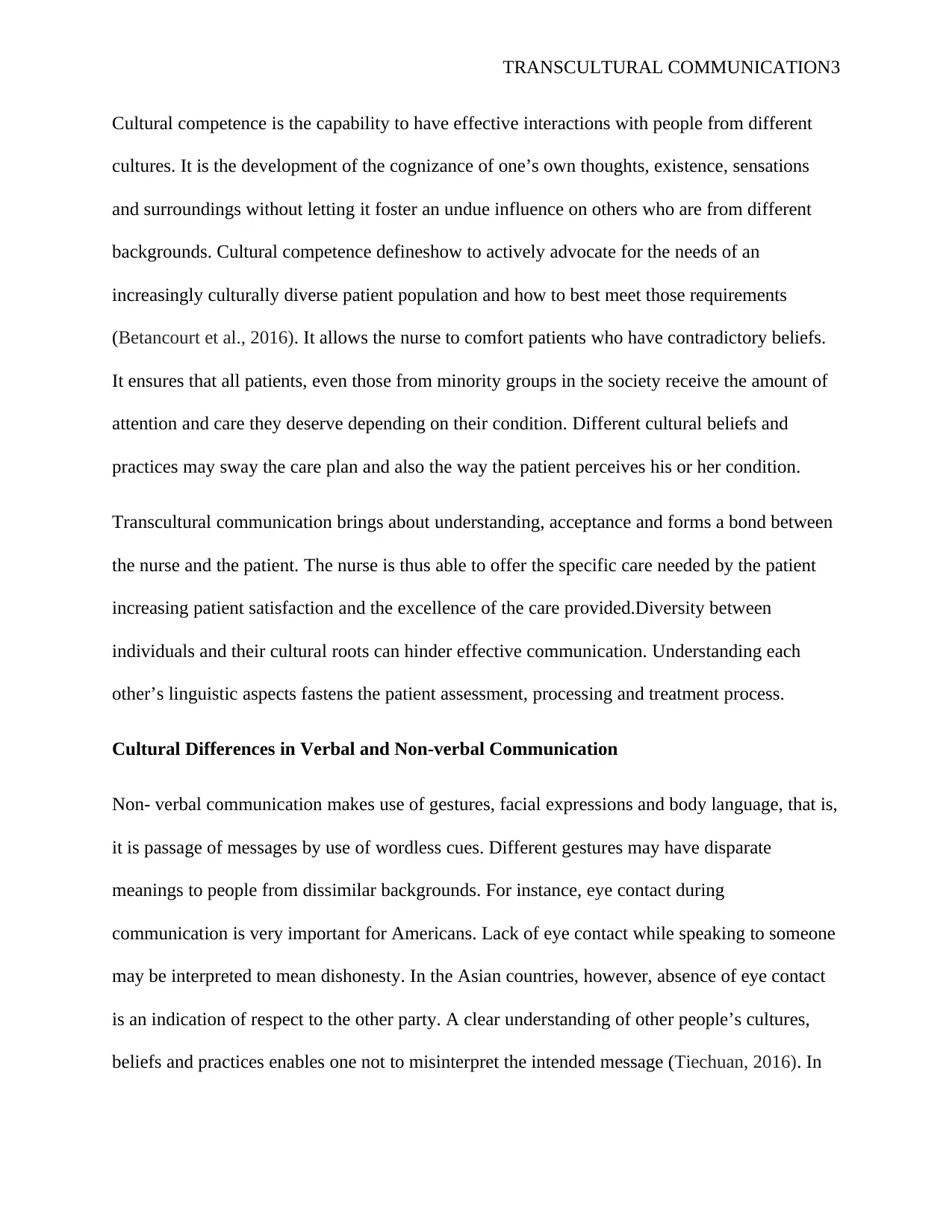
TRANSCULTURAL COMMUNICATION3
Cultural competence is the capability to have effective interactions with people from different
cultures. It is the development of the cognizance of one’s own thoughts, existence, sensations
and surroundings without letting it foster an undue influence on others who are from different
backgrounds. Cultural competence defineshow to actively advocate for the needs of an
increasingly culturally diverse patient population and how to best meet those requirements
(Betancourt et al., 2016). It allows the nurse to comfort patients who have contradictory beliefs.
It ensures that all patients, even those from minority groups in the society receive the amount of
attention and care they deserve depending on their condition. Different cultural beliefs and
practices may sway the care plan and also the way the patient perceives his or her condition.
Transcultural communication brings about understanding, acceptance and forms a bond between
the nurse and the patient. The nurse is thus able to offer the specific care needed by the patient
increasing patient satisfaction and the excellence of the care provided.Diversity between
individuals and their cultural roots can hinder effective communication. Understanding each
other’s linguistic aspects fastens the patient assessment, processing and treatment process.
Cultural Differences in Verbal and Non-verbal Communication
Non- verbal communication makes use of gestures, facial expressions and body language, that is,
it is passage of messages by use of wordless cues. Different gestures may have disparate
meanings to people from dissimilar backgrounds. For instance, eye contact during
communication is very important for Americans. Lack of eye contact while speaking to someone
may be interpreted to mean dishonesty. In the Asian countries, however, absence of eye contact
is an indication of respect to the other party. A clear understanding of other people’s cultures,
beliefs and practices enables one not to misinterpret the intended message (Tiechuan, 2016). In
Cultural competence is the capability to have effective interactions with people from different
cultures. It is the development of the cognizance of one’s own thoughts, existence, sensations
and surroundings without letting it foster an undue influence on others who are from different
backgrounds. Cultural competence defineshow to actively advocate for the needs of an
increasingly culturally diverse patient population and how to best meet those requirements
(Betancourt et al., 2016). It allows the nurse to comfort patients who have contradictory beliefs.
It ensures that all patients, even those from minority groups in the society receive the amount of
attention and care they deserve depending on their condition. Different cultural beliefs and
practices may sway the care plan and also the way the patient perceives his or her condition.
Transcultural communication brings about understanding, acceptance and forms a bond between
the nurse and the patient. The nurse is thus able to offer the specific care needed by the patient
increasing patient satisfaction and the excellence of the care provided.Diversity between
individuals and their cultural roots can hinder effective communication. Understanding each
other’s linguistic aspects fastens the patient assessment, processing and treatment process.
Cultural Differences in Verbal and Non-verbal Communication
Non- verbal communication makes use of gestures, facial expressions and body language, that is,
it is passage of messages by use of wordless cues. Different gestures may have disparate
meanings to people from dissimilar backgrounds. For instance, eye contact during
communication is very important for Americans. Lack of eye contact while speaking to someone
may be interpreted to mean dishonesty. In the Asian countries, however, absence of eye contact
is an indication of respect to the other party. A clear understanding of other people’s cultures,
beliefs and practices enables one not to misinterpret the intended message (Tiechuan, 2016). In
⊘ This is a preview!⊘
Do you want full access?
Subscribe today to unlock all pages.

Trusted by 1+ million students worldwide
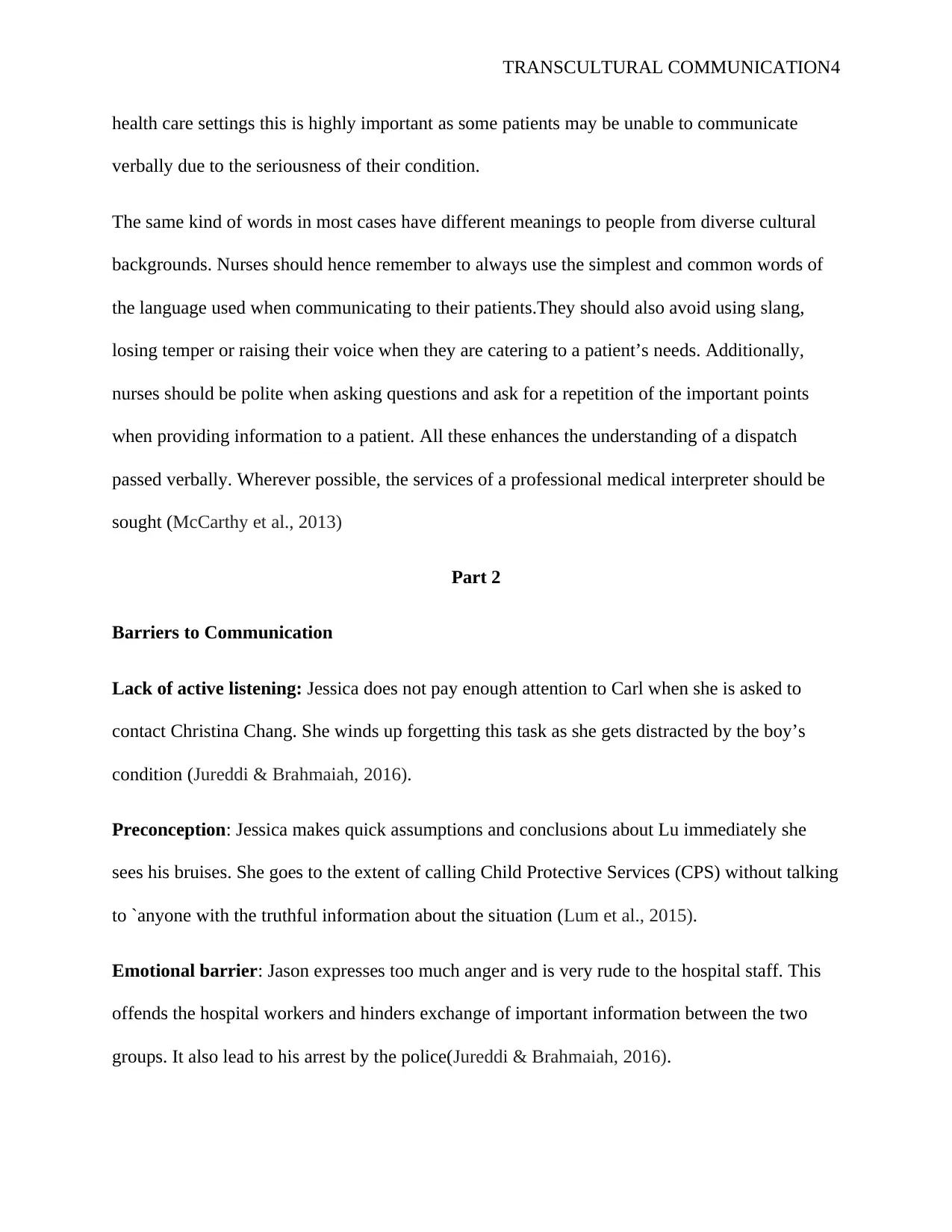
TRANSCULTURAL COMMUNICATION4
health care settings this is highly important as some patients may be unable to communicate
verbally due to the seriousness of their condition.
The same kind of words in most cases have different meanings to people from diverse cultural
backgrounds. Nurses should hence remember to always use the simplest and common words of
the language used when communicating to their patients.They should also avoid using slang,
losing temper or raising their voice when they are catering to a patient’s needs. Additionally,
nurses should be polite when asking questions and ask for a repetition of the important points
when providing information to a patient. All these enhances the understanding of a dispatch
passed verbally. Wherever possible, the services of a professional medical interpreter should be
sought (McCarthy et al., 2013)
Part 2
Barriers to Communication
Lack of active listening: Jessica does not pay enough attention to Carl when she is asked to
contact Christina Chang. She winds up forgetting this task as she gets distracted by the boy’s
condition (Jureddi & Brahmaiah, 2016).
Preconception: Jessica makes quick assumptions and conclusions about Lu immediately she
sees his bruises. She goes to the extent of calling Child Protective Services (CPS) without talking
to `anyone with the truthful information about the situation (Lum et al., 2015).
Emotional barrier: Jason expresses too much anger and is very rude to the hospital staff. This
offends the hospital workers and hinders exchange of important information between the two
groups. It also lead to his arrest by the police(Jureddi & Brahmaiah, 2016).
health care settings this is highly important as some patients may be unable to communicate
verbally due to the seriousness of their condition.
The same kind of words in most cases have different meanings to people from diverse cultural
backgrounds. Nurses should hence remember to always use the simplest and common words of
the language used when communicating to their patients.They should also avoid using slang,
losing temper or raising their voice when they are catering to a patient’s needs. Additionally,
nurses should be polite when asking questions and ask for a repetition of the important points
when providing information to a patient. All these enhances the understanding of a dispatch
passed verbally. Wherever possible, the services of a professional medical interpreter should be
sought (McCarthy et al., 2013)
Part 2
Barriers to Communication
Lack of active listening: Jessica does not pay enough attention to Carl when she is asked to
contact Christina Chang. She winds up forgetting this task as she gets distracted by the boy’s
condition (Jureddi & Brahmaiah, 2016).
Preconception: Jessica makes quick assumptions and conclusions about Lu immediately she
sees his bruises. She goes to the extent of calling Child Protective Services (CPS) without talking
to `anyone with the truthful information about the situation (Lum et al., 2015).
Emotional barrier: Jason expresses too much anger and is very rude to the hospital staff. This
offends the hospital workers and hinders exchange of important information between the two
groups. It also lead to his arrest by the police(Jureddi & Brahmaiah, 2016).
Paraphrase This Document
Need a fresh take? Get an instant paraphrase of this document with our AI Paraphraser
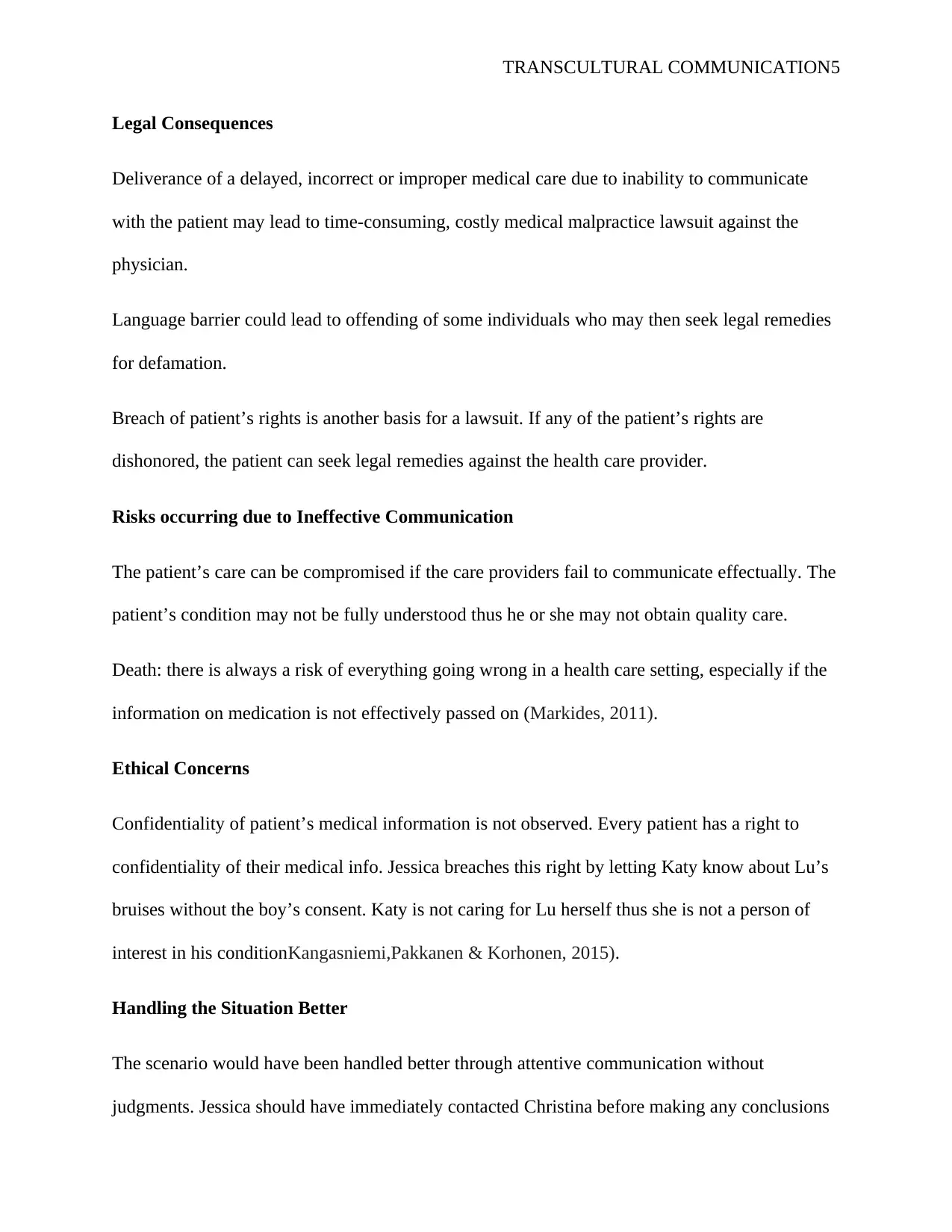
TRANSCULTURAL COMMUNICATION5
Legal Consequences
Deliverance of a delayed, incorrect or improper medical care due to inability to communicate
with the patient may lead to time-consuming, costly medical malpractice lawsuit against the
physician.
Language barrier could lead to offending of some individuals who may then seek legal remedies
for defamation.
Breach of patient’s rights is another basis for a lawsuit. If any of the patient’s rights are
dishonored, the patient can seek legal remedies against the health care provider.
Risks occurring due to Ineffective Communication
The patient’s care can be compromised if the care providers fail to communicate effectually. The
patient’s condition may not be fully understood thus he or she may not obtain quality care.
Death: there is always a risk of everything going wrong in a health care setting, especially if the
information on medication is not effectively passed on (Markides, 2011).
Ethical Concerns
Confidentiality of patient’s medical information is not observed. Every patient has a right to
confidentiality of their medical info. Jessica breaches this right by letting Katy know about Lu’s
bruises without the boy’s consent. Katy is not caring for Lu herself thus she is not a person of
interest in his conditionKangasniemi,Pakkanen & Korhonen, 2015).
Handling the Situation Better
The scenario would have been handled better through attentive communication without
judgments. Jessica should have immediately contacted Christina before making any conclusions
Legal Consequences
Deliverance of a delayed, incorrect or improper medical care due to inability to communicate
with the patient may lead to time-consuming, costly medical malpractice lawsuit against the
physician.
Language barrier could lead to offending of some individuals who may then seek legal remedies
for defamation.
Breach of patient’s rights is another basis for a lawsuit. If any of the patient’s rights are
dishonored, the patient can seek legal remedies against the health care provider.
Risks occurring due to Ineffective Communication
The patient’s care can be compromised if the care providers fail to communicate effectually. The
patient’s condition may not be fully understood thus he or she may not obtain quality care.
Death: there is always a risk of everything going wrong in a health care setting, especially if the
information on medication is not effectively passed on (Markides, 2011).
Ethical Concerns
Confidentiality of patient’s medical information is not observed. Every patient has a right to
confidentiality of their medical info. Jessica breaches this right by letting Katy know about Lu’s
bruises without the boy’s consent. Katy is not caring for Lu herself thus she is not a person of
interest in his conditionKangasniemi,Pakkanen & Korhonen, 2015).
Handling the Situation Better
The scenario would have been handled better through attentive communication without
judgments. Jessica should have immediately contacted Christina before making any conclusions
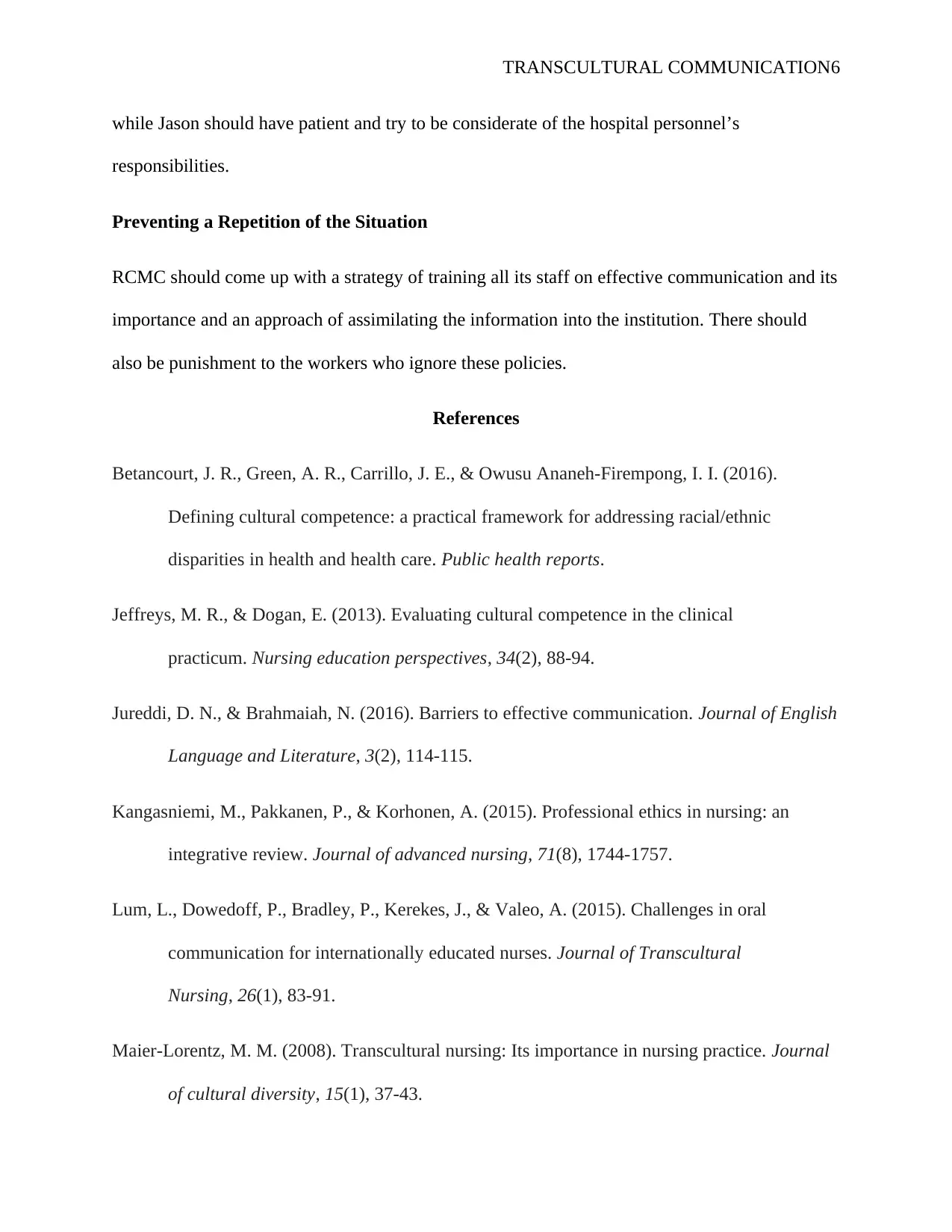
TRANSCULTURAL COMMUNICATION6
while Jason should have patient and try to be considerate of the hospital personnel’s
responsibilities.
Preventing a Repetition of the Situation
RCMC should come up with a strategy of training all its staff on effective communication and its
importance and an approach of assimilating the information into the institution. There should
also be punishment to the workers who ignore these policies.
References
Betancourt, J. R., Green, A. R., Carrillo, J. E., & Owusu Ananeh-Firempong, I. I. (2016).
Defining cultural competence: a practical framework for addressing racial/ethnic
disparities in health and health care. Public health reports.
Jeffreys, M. R., & Dogan, E. (2013). Evaluating cultural competence in the clinical
practicum. Nursing education perspectives, 34(2), 88-94.
Jureddi, D. N., & Brahmaiah, N. (2016). Barriers to effective communication. Journal of English
Language and Literature, 3(2), 114-115.
Kangasniemi, M., Pakkanen, P., & Korhonen, A. (2015). Professional ethics in nursing: an
integrative review. Journal of advanced nursing, 71(8), 1744-1757.
Lum, L., Dowedoff, P., Bradley, P., Kerekes, J., & Valeo, A. (2015). Challenges in oral
communication for internationally educated nurses. Journal of Transcultural
Nursing, 26(1), 83-91.
Maier-Lorentz, M. M. (2008). Transcultural nursing: Its importance in nursing practice. Journal
of cultural diversity, 15(1), 37-43.
while Jason should have patient and try to be considerate of the hospital personnel’s
responsibilities.
Preventing a Repetition of the Situation
RCMC should come up with a strategy of training all its staff on effective communication and its
importance and an approach of assimilating the information into the institution. There should
also be punishment to the workers who ignore these policies.
References
Betancourt, J. R., Green, A. R., Carrillo, J. E., & Owusu Ananeh-Firempong, I. I. (2016).
Defining cultural competence: a practical framework for addressing racial/ethnic
disparities in health and health care. Public health reports.
Jeffreys, M. R., & Dogan, E. (2013). Evaluating cultural competence in the clinical
practicum. Nursing education perspectives, 34(2), 88-94.
Jureddi, D. N., & Brahmaiah, N. (2016). Barriers to effective communication. Journal of English
Language and Literature, 3(2), 114-115.
Kangasniemi, M., Pakkanen, P., & Korhonen, A. (2015). Professional ethics in nursing: an
integrative review. Journal of advanced nursing, 71(8), 1744-1757.
Lum, L., Dowedoff, P., Bradley, P., Kerekes, J., & Valeo, A. (2015). Challenges in oral
communication for internationally educated nurses. Journal of Transcultural
Nursing, 26(1), 83-91.
Maier-Lorentz, M. M. (2008). Transcultural nursing: Its importance in nursing practice. Journal
of cultural diversity, 15(1), 37-43.
⊘ This is a preview!⊘
Do you want full access?
Subscribe today to unlock all pages.

Trusted by 1+ million students worldwide
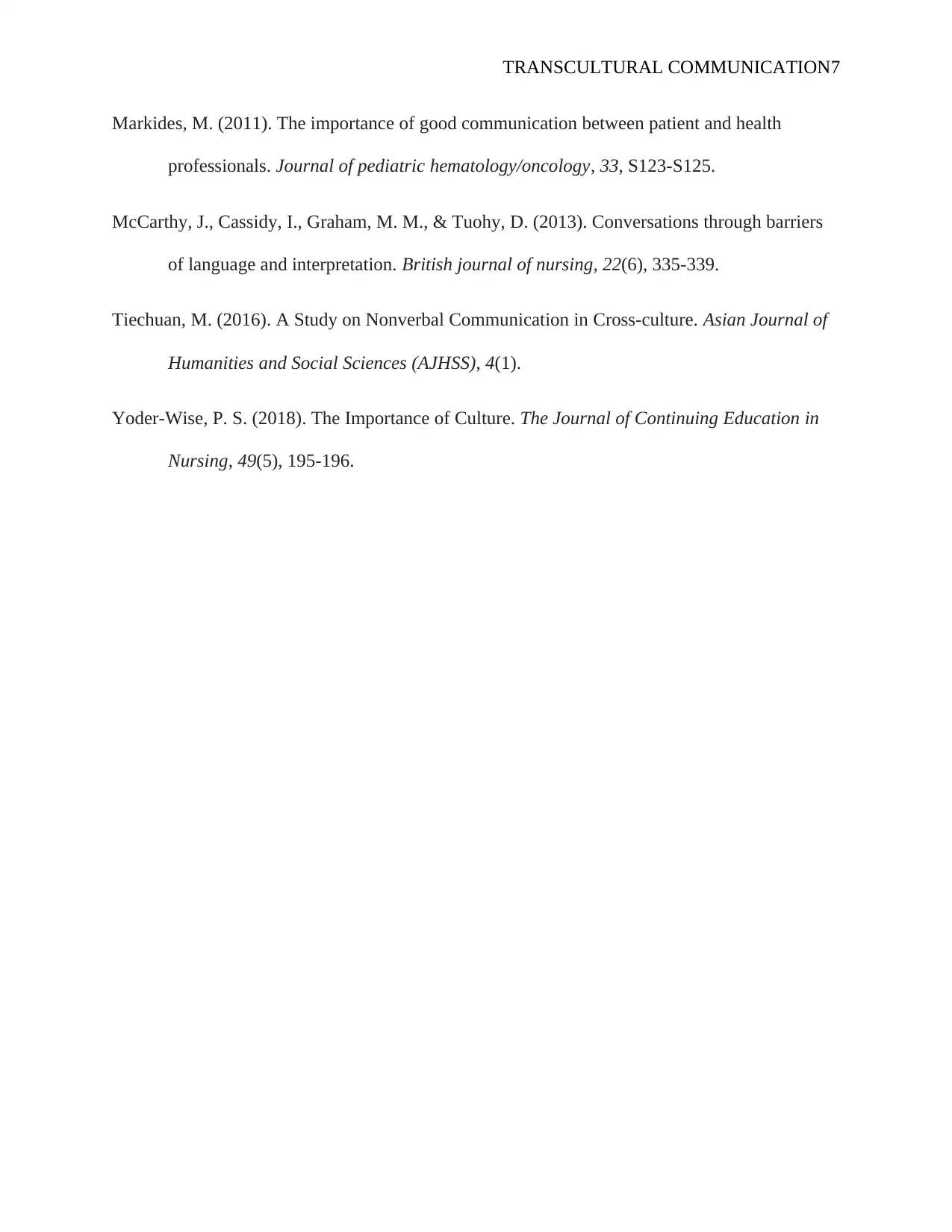
TRANSCULTURAL COMMUNICATION7
Markides, M. (2011). The importance of good communication between patient and health
professionals. Journal of pediatric hematology/oncology, 33, S123-S125.
McCarthy, J., Cassidy, I., Graham, M. M., & Tuohy, D. (2013). Conversations through barriers
of language and interpretation. British journal of nursing, 22(6), 335-339.
Tiechuan, M. (2016). A Study on Nonverbal Communication in Cross-culture. Asian Journal of
Humanities and Social Sciences (AJHSS), 4(1).
Yoder-Wise, P. S. (2018). The Importance of Culture. The Journal of Continuing Education in
Nursing, 49(5), 195-196.
Markides, M. (2011). The importance of good communication between patient and health
professionals. Journal of pediatric hematology/oncology, 33, S123-S125.
McCarthy, J., Cassidy, I., Graham, M. M., & Tuohy, D. (2013). Conversations through barriers
of language and interpretation. British journal of nursing, 22(6), 335-339.
Tiechuan, M. (2016). A Study on Nonverbal Communication in Cross-culture. Asian Journal of
Humanities and Social Sciences (AJHSS), 4(1).
Yoder-Wise, P. S. (2018). The Importance of Culture. The Journal of Continuing Education in
Nursing, 49(5), 195-196.
1 out of 7
Related Documents
Your All-in-One AI-Powered Toolkit for Academic Success.
+13062052269
info@desklib.com
Available 24*7 on WhatsApp / Email
![[object Object]](/_next/static/media/star-bottom.7253800d.svg)
Unlock your academic potential
Copyright © 2020–2025 A2Z Services. All Rights Reserved. Developed and managed by ZUCOL.




